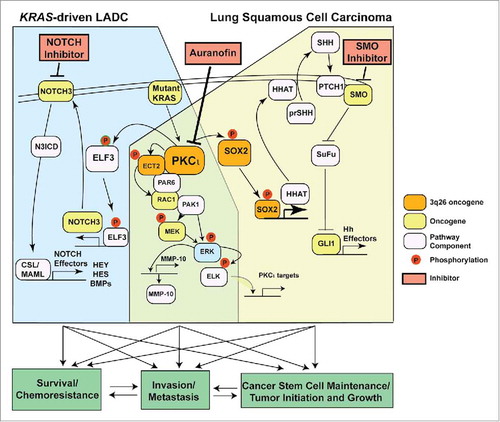Figures & data
Figure 1. PKCι drives both common and lineage-specific oncogenic pathways in lung cancer. In KRAS-driven lung adenocarcinoma (KRAS-driven LADC) PKCι acts as a critical downstream KRAS effector, activating a novel PKCι-ELF3-NOTCH3 signaling axis that establishes and maintains a KRAS-driven LADC TIC phenotype. In lung squamous cell carcinoma (LSCC) harboring 3q26 amplification, the 3q26 genes PRKCI, SOX2, and ECT2 are coordinately amplified and overexpressed, leading to lineage-specific activation of a PKCι-SOX2-HHAT signaling axis. This pathway drives a Hedgehog-dependent LSCC tumor-initiating cell (TIC) phenotype characterized by highly aggressive tumorigenic and invasive behavior and enhanced survival and chemoresistance. The PKCι gene target GLI1 is a major effector of this pathway. PKCι also activates a PKCι-ECT2-RAC1-MEK-ERK signaling pathway that drives transformed growth and invasion of both KRAS LADC and LSCC cells. The PKCι target matrix metalloproteinase 10 (MMP10) is a major effector of this pathway. The PKCι inhibitor auranofin exhibits antitumor activity against both LSCC and KRAS-driven LADC, and exhibits lineage-specific synergistic activity when combined with a NOTCH inhibitor in KRAS-driven LADC and a SMO inhibitor in LSCC.

